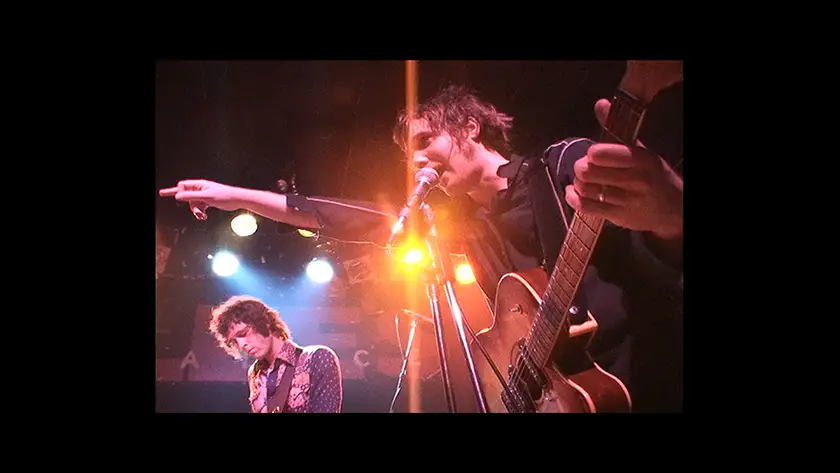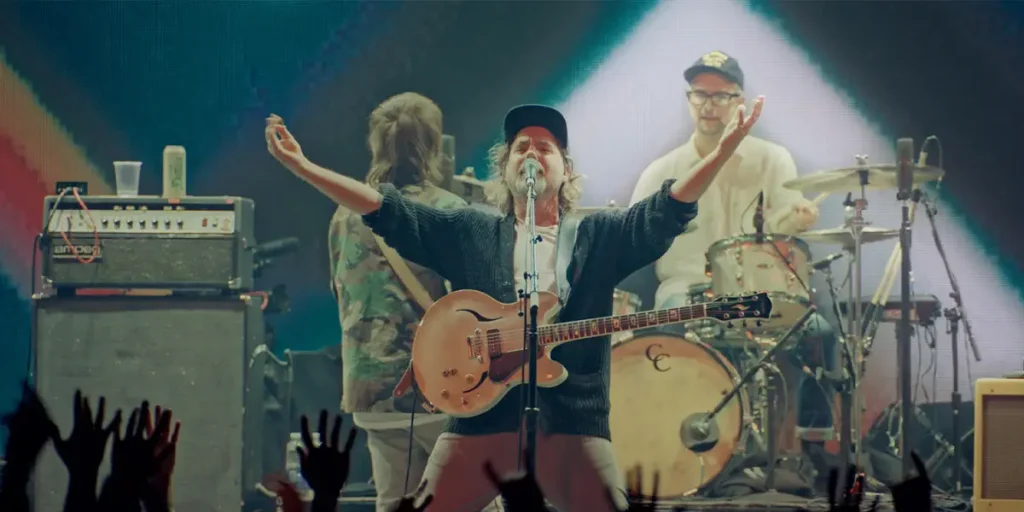Toronto’s Broken Social Scene get the rockumentary treatment in It’s All Gonna Break, a nostalgia-heavy paean to ‘00s indie rock.
Director: Stephen Chung
Genre: Documentary, Music
Run Time: 94′
Featuring: Kevin Drew, Leslie Feist, Brendan Canning, Emily Haines, Amy Millan
U.S. Release: May 30, 2025 (limited)
U.K. Release: TBA
Where to Watch: In select US theaters including NY & LA
With their large multi-instrumental ensemble and a name seemingly cobbled together by throwing darts at a board, one could argue that Broken Social Scene is as archetypal a ‘00s indie band as they come. It’s worth noting, though, that they were one of the first of that wave of baroque pop collectives, and an evident influence on subsequent artists with the orchestra-infused sound so associated with the era. And that’s part of what makes It’s All Gonna Break a more interesting prospect than the average rockumentary: we bear witness to the birth of a style and ethos that would help shape rock music for the next decade.
The documentary brings together extensive footage captured by director and friend of the band Stephen Chung, a relic of a pre-smartphone era but with a comprehensiveness that could rival any iPhone camera roll. This remarkable visual record begins with the group’s early jams and rehearsals and takes us through the release of their first few albums, major festival performances and network TV appearances. Chung hadn’t originally intended for them to be used in a film, but did at one point, unsuccessfully, float the idea with the band; that plan has at long last come to fruition, complete with fresh interviews with core members Kevin Drew and Brendan Canning, alongside a large roster of other BSS instrumentalists, collaborators and friends.
The fact that the clips we see were not taken with a documentary in mind gives them a lot of their charm and makes for a more involving experience. After a hi-res prologue of sorts featuring Chung and his son – born during the era the film covers – we are plunged into the grainy world of early 2000s Toronto, a time and place impressively fleshed out by the sheer range of footage and additional commentary from those who were there. Chung does well to put the moment in context, exploring the fallout of ‘90s grunge, the Canadian music industry’s slowness to catch on to US trends, and the country’s general treatment by major labels across the border as a neglected outpost. Then there’s the fact that Toronto was once a relatively cheap metropolis, making it a breeding ground for independent artists and musicians; today’s young Torontonians may find that part hard to believe.

It truly is a time capsule of life in the city, something that perhaps those outside of BSS megafans, myself included, will find more engaging than the music itself. The true acolytes will be delighted by the breadth of previously unseen content on display as they behold the evolution of some of the group’s most famous numbers in real time, but for the casual listener, the density can be overwhelming. We spend a lot of time simply existing with the musicians, in rehearsals, backstage, on the streets, at house parties, and that will test the patience of anyone not fully invested in the group. While this approach worked so well in Peter Jackson’s Get Back, it doesn’t quite give us the same thrills with a band that is, and I hope they won’t mind me saying this, significantly less interesting than The Beatles.
Nonetheless, there’s something powerfully nostalgic about that blend of crunchy guitars and majestic brass and strings, the one we used to hear all the time on teen dramas, early YouTube videos and adverts for digital cameras, just as there is about the fashion, haircuts and pop culture nuggets that crop up throughout the clips. Fan of the group or not, any indie lover born before 1995 will struggle to avoid getting swept up in the sounds and images of the era.
As It’s All Gonna Break reaches its conclusion, Chung looks back on the band’s decision to wait a while before releasing all this footage to the wider world: ‘They were right,’ he says, ‘The story wasn’t ready.’ I’m not sure it’s entirely obvious why the story is ready now; there’s little structure to his film, no significant conflict, nor any new work from the group on the horizon – though an album of covers by other artists of their breakout record “You Forgot It In People” is out soon. In any case, what is evidently foremost in the filmmaker’s mind is reconnecting with the vast community of musicians, friends and fans of Broken Social Scene, who will all surely love it.
It’s All Gonna Break: Movie Plot & Recap
Synopsis:
Friend of the band Stephen Chung captures the story of Broken Social Scene, and the flourishing of Toronto as an artistic hub that accompanied their rapid rise in the early 2000s.
Pros:
- Copious raw footage from the band’s heyday
- Impressive roster of talking heads
- A heartfelt paean to both the band and their city
Cons:
- The sheer amount of footage can be overwhelming
- Little structure or conflict to speak of
- For fans, and perhaps the wider Toronto arts community, only
It’s All Gonna Break will be released in US theatres in select cities, including New York and Los Angeles, on May 30, 2025.

